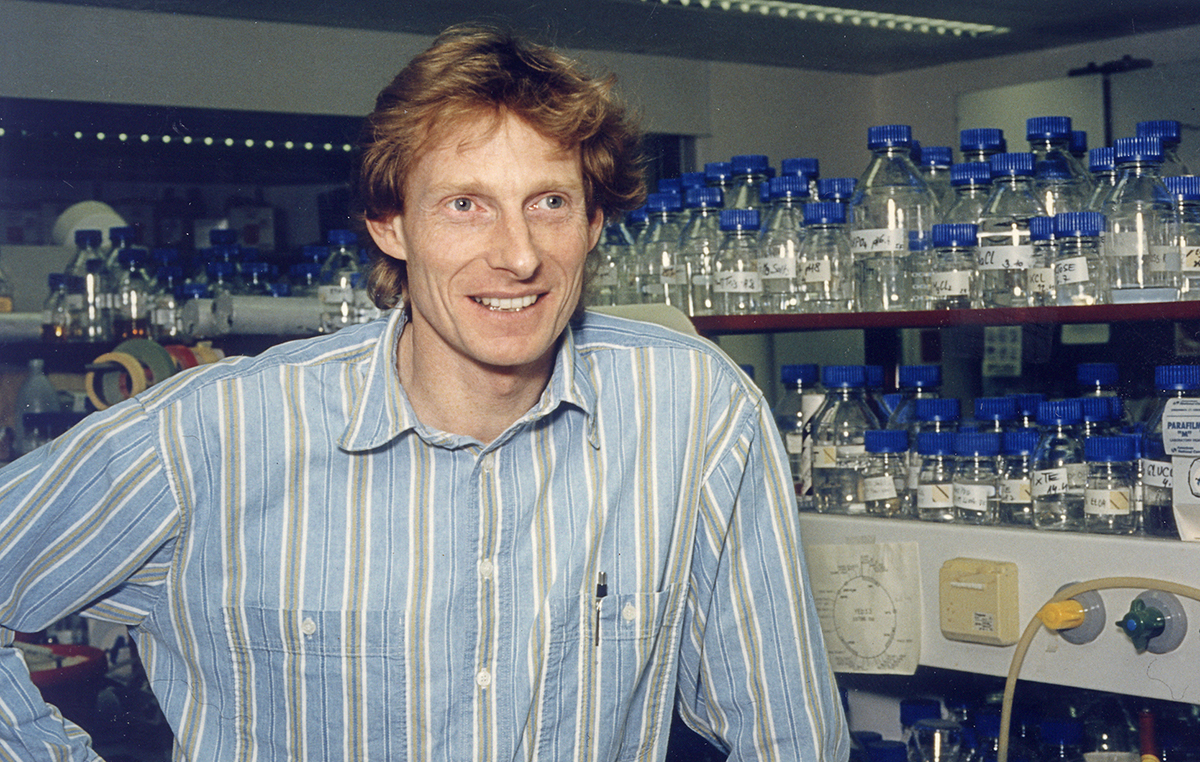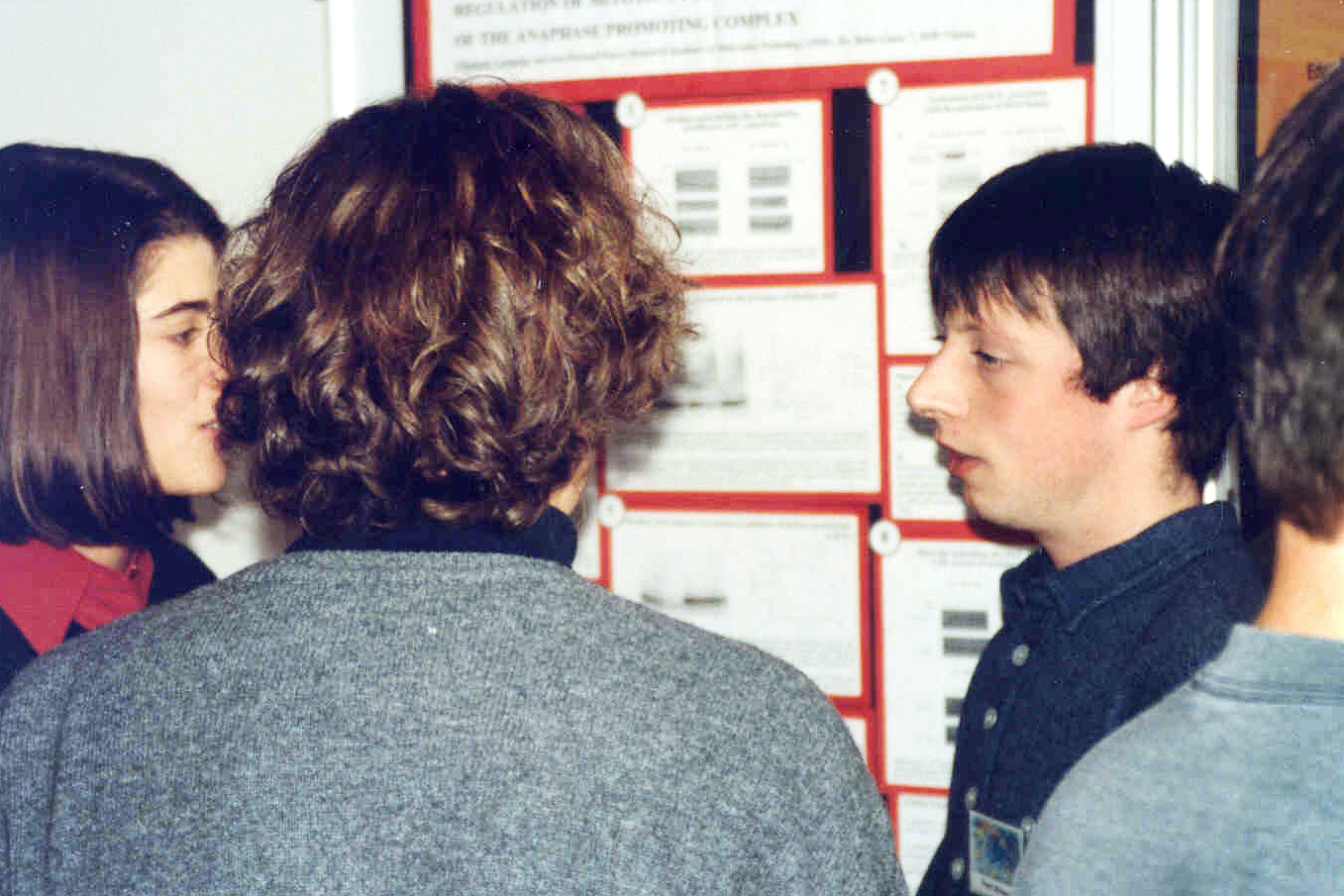Using baker’s yeast to understand universal principles of chromosome segregation
During Kim Nasmyth’s time as a group leader (including nearly 10 years as Scientific Director) at the IMP in Vienna, Austria, he and his colleagues uncovered some of the fundamental mechanisms that enable the meticulous segregation of chromosomes during cell division. Their discoveries triggered what Kim would describe as a “chain reaction of knowledge”, which to this day has not lost momentum.
At the end of 2017, Kim Nasmyth could be seen among Hollywood stars such as Morgan Freeman, Mila Kunis and Ashton Kutcher at a glamourous awards ceremony. Rather than having anything to do with films though, this awards ceremony, held at NASA’s Ames Research Center in California’s Silicon Valley, was to recognise five distinguished scientists with the 2018 Breakthrough Prizes in Life Sciences, the most highly endowed awards in the sciences. Kim was awarded the prize for his work ‘elucidating the sophisticated mechanism that mediates the perilous separation of duplicated chromosomes during cell division and thereby prevents genetic diseases such as cancer’. It is the latest recognition of Kim’s long and successful career, of which nearly 20 years were spent at the IMP.

Kim was one of the first senior scientists to be invited to join the IMP by the Swiss molecular biologist and IMP Founding Director Max Birnstiel in 1987. At the time, Kim was safely settled at the MRC Laboratory of Molecular Biology in Cambridge, UK, and was initially sceptical. But his wife Anna suggested he find out more: “If it wasn’t for her, I probably wouldn’t have rung Max back”, recalls Kim. He decided to go for it. “It was a crazy thing to do really – the IMP could have sunk without a trace”. But the element of the risk-taker in him, as well as the conviction that putting oneself in a new environment often fuels success not otherwise achieved by staying put, convinced him to make the move. “And Cambridge is an awfully long way from mountains”, adds Kim, an enthusiastic climber. Having been working on gene silencing in Cambridge, Kim changed his focus back to the cell cycle. “I could see that as being more readily applicable in the context of oncology”, says Kim, mindful of the proposed cancer focus of the new institute and of the companies providing the funding, Boehringer Ingelheim and Genentech. But he continued using yeast as a model system because of the unparalleled power of its genetics and the ease of identifying conditional mutants in important genes.
Kim was intrigued by the oscillatory nature of the cell cycle, with its periodic synthesis and degradation of ‘cyclins’. However, investigating this genetically was challenging as cyclin degradation is inactive for much of the cell cycle. Kim’s group designed elegant and innovative approaches to overcome this challenge and used them to discover the first genes of a large protein complex – the anaphase-promoting complex/cyclosome (APC/C) – which they showed was essential for cyclin degradation and chromosome segregation (Irniger et al., Cell 1995; Zachariae et al., Science 1996). This seminal discovery made it possible to look for mutants that could separate sister chromatids even without a functional APC/C. Exploiting this strategy, Christine Michaelis, a postdoc in the lab, identified three new genes required for sister chromatid cohesion (Michaelis et al., Cell 1997), which we now know encode subunits of the cohesin complex.

Having identified the complex that held chromatids together, the next logical step was to investigate how they were separated again. A protein later dubbed ‘separase’ was known to be involved, but it was not known what it did. At that time, Frank Uhlmann (now a group leader at the Francis Crick Institute in London) joined the lab as a postdoc. While Kim had left for a six-week mountaineering expedition in the Himalayas, Frank set about purifying yeast chromatin associated with cohesin, and then adding yeast extracts containing high levels of separase. To his excitement, the extracts caused cleavage of the Scc1 component of cohesin that he was assaying. However, yeast extracts are notorious for unspecific proteases and the finding was met with scepticism. “A period of uncertainty ensued”, explains Frank. “But I wasn’t ready to give up.” He reasoned that, if specific, the cleavage should be inhibited by adding securin, a known anaphase inhibitor. It worked. “It was a moment of incredible relief and jubilation”, recalls Frank. Further experiments revealed that separase is a protease that specifically cleaves the Scc1 component to release cohesin and allow sister chromatid separation separation (Uhlmann et al., Nature 1999;, Uhlmann et al., Cell 2000).
Despite this rapid progress, it was still not clear how cohesin actually held the chromatids together. Kim suspected that, rather than being physical, the stable association might be topological, with cohesin forming a ring around the sister chromatids. Cleavage of Scc1 by separase would therefore serve to ‘open’ the ring. That turned out to be the case: cleavage of a cohesin component other than Scc1 (in other words, ‘cutting’ the ring in a different place) was sufficient to release cohesin, and additional experiments strongly supported the ‘ring hypothesis’ (Gruber et al., Cell 2003;, Ivanov et al., Cell 2005). Going back to his passion for climbing, Kim likens the model to the way ropes can be held together by carabiners and released by opening the ‘gate’ of the carabiner: cohesin complexes are the carabiners, with Scc1 being the gate.

These remarkable discoveries explain in molecular terms how sister DNA molecules are held together until they segregate in mitosis or meiosis. Beyond this, Kim’s ring hypothesis also had an important impact on other fields. To give just one example, the hypothesis indicated that protein complexes related to cohesin might also act as molecular rings to entrap DNA. Indeed, this has been shown for SMC complexes, which segregate bacterial genomes; therefore, the entrapment of DNA by cohesin-related complexes may have been essential for the evolution of DNA genomes and their segregation mechanisms. As well as shedding light on fundamental biological processes, the ring hypothesis provides a molecular basis for understanding the aetiology of human diseases caused by cohesin defects. Cohesin and its regulators are among the genes most frequently mutated in cancer, and work is ongoing to understand the functional importance of these mutations, which will ultimately lead to improved diagnosis and treatment.
Kim helped establish the IMP as a leader on the international stage of molecular biology research, not only through his ground-breaking research, but also through his leadership and vision. Crucially, he attracted and trained many brilliant minds, including the winner of the 2019 Breakthrough Prize, Angelika Amon, who was one of the first PhD students at the IMP. It was also Kim’s idea to create a sister institute for the IMP, IMBA, in cooperation with the Austrian Academy of Sciences, and it was his and Jeff Schatz’s vision to unite the molecular biology institutes next door into what is known as Max F. Perutz Laboratories (MFPL) today.
Kim’s legacy continues to impact the institute now, more than a decade after he left to become head of the Department of Biochemistry of the University of Oxford. His contributions continue to inspire young researchers at the IMP, whose curiosity, ambition and imagination will lead to the next major breakthroughs. As Kim put it at the awards ceremony in Silicon Valley: “You can’t explain the world in terms of what you already know – you’re going to have to imagine something new”.
First published in 2019.
References
Genes involved in sister chromatid separation are needed for B-type cyclin proteolysis in budding yeast.
Irniger S, Piatti S, Michaelis C, Nasmyth K; Cell 1995
Identification of subunits of the anaphase-promoting complex of Saccharomyces cerevisiae.
Zachariae W, Shin TH, Galova M, Obermaier B, Nasmyth K; Science 1996
Cohesins: chromosomal proteins that prevent premature separation of sister chromatids.
Michaelis C, Ciosk R, Nasmyth K; Cell 1997
Sister-chromatid separation at anaphase onset is promoted by cleavage of the cohesin subunit Scc1.
Uhlmann F, Lottspeich F, Nasmyth K; Nature 1999
Cleavage of cohesin by the CD clan protease separin triggers anaphase in yeast.
Uhlmann F, Wernic D, Poupart MA, Koonin EV, Nasmyth K; Cell 2000
Chromosomal cohesin forms a ring.
Gruber S, Haering CH, Nasmyth K; Cell 2003
A topological interaction between cohesin rings and a circular minichromosome.
Ivanov D, Nasmyth K; Cell 2005